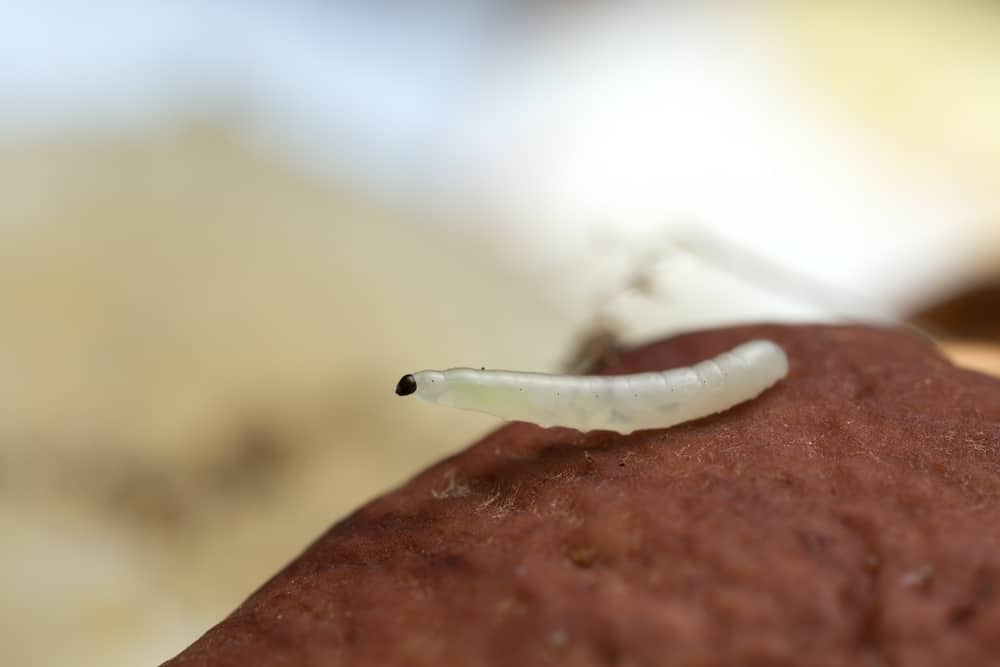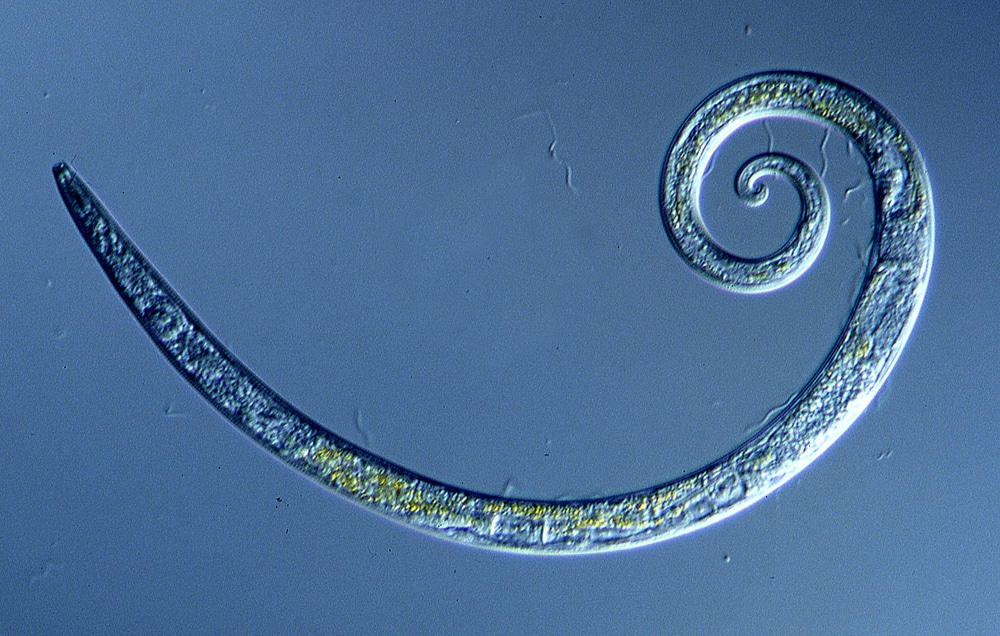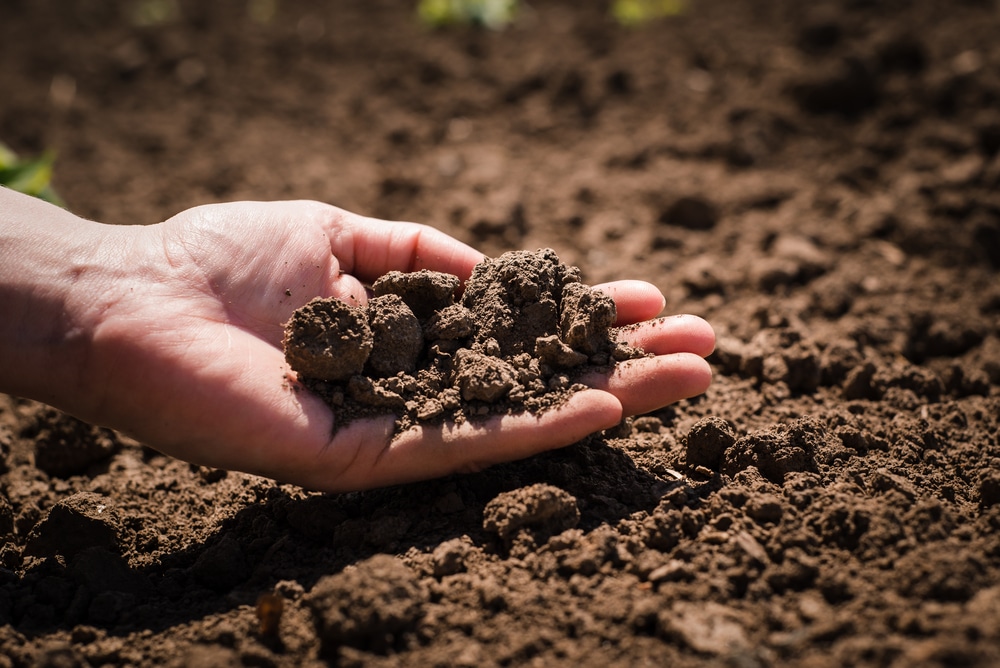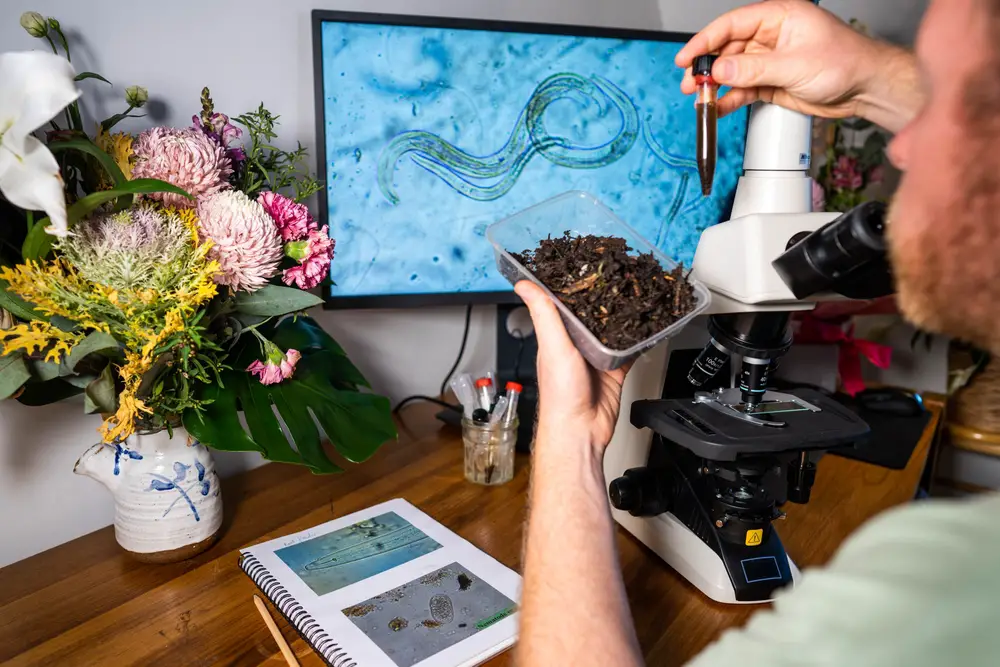Summary
Many organisms can be the tiny white worms in your soil. Some examples include:
- Pot worms
- Fungus gnat larvae
- Nematodes
It’s important to note those tiny white worms are there for good reason, and they benefit your plants and soil.
Some benefits include:
- Consuming dead organic matter
- Providing nutrients to plants
- Consuming pests (some nematodes do this)
It is possible for them to cause problems as well. For example, fungus gnat larvae can feed on plant roots. This can damage your plants, especially seedlings. Some nematodes do the same.
Unless you’re noticing issues with your plants’ health, overwatered soil (which is attractive to organisms such as pot worms and fungus gnat larvae), or related issues, you’re better off leaving the tiny white worms in your soil alone.
However, wearing gardening gloves and washing your hands well after working your garden to prevent contact is a good idea, but that’s just good practice anyway.
Last, you can always consult with a professional if you need to.
Is it a pest, or is it not a pest?
That has our vote to be a game show. Moreover, it’s likely a game show you’ve already been on a few times.
You’re trimming plants, watering, or doing other tasks, and you notice strange organisms in your soil. Your mind starts racing. Are they hurting your plants, benefitting them, or doing nothing at all?
It can be hard to know!
It’s just one of the challenges of being a gardener.
Now, you’re playing the game show again, this time with tiny white worms in your soil.
So, are they hurting your plants, benefitting them, or doing nothing at all?
More importantly, what in the world are they?
As a quick side note, below are only a few examples of tiny white worms in your soil. Always consult with a local professional for assistance in these matters, especially if you’re seeing negative effects on your plants.
With that said, let’s start with pot worms.
Pot Worms
Pot worms are very small (we’re talking millimeters), somewhat transparent, white to gray, and they wriggle to move.
You might have pot worms in your soil if they have these identifying factors.
Additionally, pot worms help break down dead organic matter. They process that matter and turn it into nutrients for your plants.
The biggest sign you have pot worms, though, is your soil’s moisture. Simply put, pot worms like moist soil. So, the more moist your soil is, the more likely they are to be there.
In fact, one of the reasons you’re more likely to find pot worms in pots and other plant containers (I wonder where their name came from!) is that they’re more likely to have issues with drainage and overwatering.
Of course, you can solve these issues by improving the drainage and reducing your water. Just be careful to not underwater, as that’ll cause other issues.
Fungus Gnat Larvae

Fungus gnat larvae grow up to no more than a quarter of an inch, they’re white to cream in color, translucent, and have black heads.
They also live near roots, which makes them hard to find and identify in the first place. Still, it is possible for you to find them through digging or see them near the soil’s surface if they end up there.
You can also bet that if you see fungus gnat adults in your soil, you have fungus gnat larvae, too.
Like pot worms, the biggest sign you have fungus gnat larvae is overwatered soil. Fungus gnats and their larvae prefer this type of environment.
Also, like pot worms, fungus gnat larvae help break down dead organic matter. Unlike pot worms, fungus gnat larvae are more likely to feed on plant roots as well. This can affect mature plants but is more likely to affect seedlings.
You can treat them in a variety of ways, such as sprinkling cinnamon on your soil or reducing how much and how often you water (while staying careful not to underwater).
Nematodes

Nematodes could be the tiny white worms in your soil. However, you’re only going to notice them with a microscope. Most grow to be no more than 2.5 millimeters (0.09 inches) long.
A pencil tip is 1 millimeter. So, without microscopic assistance, you’d be looking for something 2 and 1/2 pencil tips long.
Still, it’s worth knowing that nematodes are highly likely to be in your soil.
The good news is that, for the most part, they’re beneficial. They consume dead organic matter, bacteria, fungi, and even pests.
Unfortunately, some nematodes feed on plant roots. Others can be parasitic toward humans.
The best thing you can do to circumvent any problems is to wear gloves while gardening and wash your hands well.
You can also take steps such as planting biofumigant plants (they release substances that naturally suppress nematodes), but you can also consult with a professional for help. They’ll be able to tell you if you even need to do anything!
What Causes Tiny White Worms In Your Soil?
For the most part, tiny white worms in your soil are normal and natural. You should expect them to be there.
Problems arise if there are too many or you have the wrong kind. Typically, this indicates another issue, though. This includes such issues as overwatering, so let’s start with that.
Overly Moist Or Overwatered Soil
Your soil can get overly moist or overwatered in various ways. These ways include:
- Extreme or prolonged rainfall
- Poorly draining soil (or containers)
- Compacted soil (packed down soil)
- Human error (watering too much or too often)
Any one of these can cause issues with your soil and how much water it’s holding. Together, they can make these issues worse.
Unfortunately, organisms like pot worms and fungus gnats love this type of environment. This can lead to them overpopulating.
In the case of fungus gnat larvae, a larger population means more potential damage to your plants’ roots. Add this to plants already suffering from overwatering, and you’ve got some work to do to start balancing things out and helping your plants recover.
Dead Organic Matter
Pot worms, fungus gnats and their larvae, and nematodes feed on dead organic matter. It’s their job in nature: to eat dead organic matter and transform it into nutrients for plants.
If you have a garden, you’re going to have dead organic matter (even without adding such matter as compost to your soil). It’s a normal and natural part of the gardening process and nature’s cycle.
So, you’re also going to have tiny white worms, such as pot worms, fungus gnats, and nematodes.
Plant Roots
Nematodes and fungus gnat larvae feed on plant roots. This can become an issue if it starts affecting your plants’ health.
Especially keep an eye on younger plants. They will be more susceptible.
Other Microorganisms
Some nematodes prey on other microorganisms, such as bacteria, fungi, and pests. Just because you have bacteria, fungi, and pests doesn’t mean you’ll have that kind of nematode, though. It just means you’re more likely to.
They Were In Soil You Bought
There’s always a chance that any soil you purchased for your garden (or house plants) has these microorganisms in it. Whenever you can, purchase soil from local and reputable sources. This way you will avoid introducing potential pests from other areas that could threaten your soil ecosystem.
If you are purchasing bagged soil, open the bag and sift through it, examining the soil before using it. If you notice any flies, possible larvae, or even a slightly bad smell, return it to where you have purchased it and let them know.
What About Tiny White Worms In Soil Indoors?
There’s nothing different in terms of tiny white worms in your soil indoors versus your soil outdoors. They’ll be there for the same reasons (except rainfall, of course), and they should be.
Again, your only concern is if you have too many or the wrong kind.
When You Should Be Concerned About Tiny White Worms In Your Soil

You should only be concerned about tiny white worms in your soil if you’re noticing the overwatering issue mentioned above, or if you’re noticing effects on your plants’ health.
With regards to the latter, look for anything out of the ordinary, such as but not limited to:
- Leaves turning yellow
- Your plant is wilting
- Your plant’s growth is suffering or inhibited
Additionally, in the case of nematodes, you should be concerned if you have the kind that are parasitic to humans.
What You Should Do If You See Tiny White Worms In Your Soil
In short, unless you’re noticing any problems with your plants or soil, don’t do anything. Leave those worms alone. They’re there to do a job, and their job benefits the soil and your plants.
However, we recommend wearing gloves while working with soil.
Additionally, without professional assistance, it’s difficult to know what those tiny white worms are. Nematodes, fungus gnats, and pot worms are only some examples of what they could be.
Taking steps without professional assistance or without the certainty of what those tiny white worms are and what they’re doing could have detrimental effects on your plants, soil, and garden.
So, if you’re concerned about the worms and unable to identify them, consult with a local professional. See what they have to say, and work with them to come up with a solution if one is even needed.
If a solution is needed, we stress an organic solution, not an artificial or chemical one.
